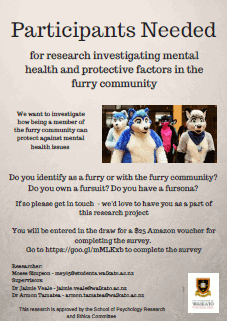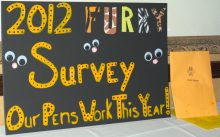survey
Fursuits and fursuiting survey by Charleston Rat
Posted by Charleston Rat on Tue 12 Oct 2021 - 05:02 Some of you might be familiar with my Facts About the Furry Fandom video on YouTube. After it went viral, I decided to make a series out of it, following it up with More Facts About the Furry Fandom and Facts About Furry Meetups & Conventions.
Some of you might be familiar with my Facts About the Furry Fandom video on YouTube. After it went viral, I decided to make a series out of it, following it up with More Facts About the Furry Fandom and Facts About Furry Meetups & Conventions.
The next video in the series will be about fursuits and fursuiting. However, unlike the previous videos, most of the information I'm looking for isn't easy to find via reliable sources like FurScience and [adjective][species]. Therefore, I've decided to take a different route.
I've created a short survey about fursuits and fursuiting which I'd like you to fill out. Most of it consists of "yes/no" and "choose what you prefer" questions, with a few exceptions. You don't need a fursuit to take part! You just have to be a furry.
Also, feel free to spread the word about this survey in other furry social media!
At the end of the survey, you can enter your name into a prize draw and potentially win $250. As long as you're over 18, and can accept a PayPal transfer, you're eligible for the draw if you complete the survey before the deadline. More details are in the survey's introduction.
The deadline is Friday, November 26, 2021.
New Zealand researcher probes furry mental health impact
Posted by GreenReaper on Sun 21 May 2017 - 13:31 From time to time, furries face mental health problems. But does fandom involvement hurt - as professionals sometimes suggest - or help? One man aims to find out.
From time to time, furries face mental health problems. But does fandom involvement hurt - as professionals sometimes suggest - or help? One man aims to find out.
This research is seeking to investigate how members of the furry community cope with stressors and mental health issues and whether being a member of the furry community can be a protective factor against stress. We also want to investigate how a person’s fursona/furry identity and their actual identity interact and any differences/similarities between them.
The research is being conducted by Moses Simpson, a Master's student at the University of Waikato.
While questions about fursonas are included, any resulting discussions are to be limited to general trends due to concern over identifiability. The survey should take less than an hour. As a bonus, participants (16+ only) may enter a drawing for one of three US$25 Amazon vouchers.
Preceding research: Survey suggests furries 'think differently', but aren't crazy (by the ARP).
Survey suggests furries 'think differently', but aren't crazy
Posted by GreenReaper on Mon 21 Oct 2013 - 15:47Recently published survey results suggest there is "little relationship between furries and clinical diagnoses of psychological dysfunction". However, those identifying more strongly as furries tended to report "particularly active, vivid and magical mental worlds", and furries (at ~4%) were "at least 2.25 times more likely to have Asperger's Syndrome" than the general population, even after controlling for different sex ratios.
Being furry was not associated with anxiety disorders or medical conditions; indeed, it was "marginally associated with psychological and relationship well-being" (B=.062-3, p=.083-.079). Furries identifying as therians did not differ from non-therian furries on measurements of most psychological conditions, well-being or health, but differed in several cognitive factors, and were more likely to have been diagnosed with an anxiety disorder (B=.099, p=.008).
The survey was conducted at Anthrocon 2013 by the Anthropomorphic Research Project. Researchers gave 820 adult participants questions that "assessed symptoms frequently associated with clinical lycanthropy, as well as numerous scales which assessed various indicators of physical and psychological well-being", with the goal of "understanding why the furry fandom is so frequently associated with dysfunction in popular culture and lay theory".
Survey: Furry fandom in digital spaces
Posted by GreenReaper on Sun 20 Oct 2013 - 12:55Ben Walker, a British undergraduate student at Keele University in Staffordshire, is conducting research on the design of online social spaces. He has created a brief survey for members of the fandom and is seeking candidates for interviews and focus groups.
[The] point of this research is to aid the design of online social spaces. If forums and community sites can be made to fit their communities better, the experience users get from them improves.
This project combines my two degree subjects, Computer Science and Geography (the human centric stuff) with the aim of utilising both to provide some tangible benefits to online communities. Being on the edge of the fandom I thought looking at Furries would be more interesting.
The project supervisor is Dr D.C McKay of the School of Physical and Geographical Science. Those interested in participating may complete the survey linked above, or email Ben.
ARP launches fursona survey, runs reaction tests at AC 2013
Posted by GreenReaper on Thu 4 Jul 2013 - 07:32 Members of the Anthropomorphic Research Project have launched a new online survey about fursonas, to answer "questions furries (and psychologists alike) have been asking", covering the relationship between:
Members of the Anthropomorphic Research Project have launched a new online survey about fursonas, to answer "questions furries (and psychologists alike) have been asking", covering the relationship between:
[…] furries and their fursonas, including the perceived functions of fursonas, the ways they manifest themselves for different furries, and the extent to which furries see their fursonas as being similar or different from their own personality.
Participants, who must be 18 or over, have the option to enter a draw for a $50 Amazon gift certifiate in return for the 20-30 minute survey. The group is also running reaction time tests at Anthrocon 2013 in the Westin on Friday and Saturday, focused on how furs see:
[…] the complex relationship between human beings and animals on this planet.
The team is still signing participants up for their existing longitudinal survey.
Read more: Past survey results from the Anthropomorphic Research Project
Furry con surveyed on porn, fantasy, pets, politics & bronies
Posted by GreenReaper on Sun 26 May 2013 - 16:59 Results have been released from an Anthropomorphic Research Project survey of 455 furs taken at Furry Fiesta 2013.
Results have been released from an Anthropomorphic Research Project survey of 455 furs taken at Furry Fiesta 2013.
- 78% of females and 96% of males report viewing furry porn. Both groups underestimated both figures by 8-12%.
- Increasing furriness indicated a tendency to use fantasy for various purposes, including escapism, but didn't indicate blurring of reality, or an inability to have fun, self-motivate, fulfil needs, socialize, or cope with problems without fantasy.
- Female furs had less sexual roleplay, owned less pornography, viewed it less frequently, and felt it had less influence on their joining the fandom. They also saw pornography as more openly discussed within the fandom.
- Furries overestimated the positivity of both male and female furs towards furry porn: males tended to be positive or mixed, while over 20% of females had a negative view. 51% of furs preferred porn over general furry artwork; 17% had the opposite view. ~55% saw non-furry pornography in a negative light; some males only view furry porn.
- Non-brony furs rated bronies less positively (50) than furries (79) or non-furs (61).
- Furries are very liberal on social matters, but more moderate on economic topics.
- Therians anthropomorphise animals more than non-therian furs; those strongly identifying as furries gave human characteristics to both regular and stuffed animals.
Around half of those participating chose to join the group's three-year longitudinal study.
On [adjective][species]: JM revisits Dr. Gerbasi's original study – Nuka responds
Anthropomorphic Research Project launches 3-year study
Posted by GreenReaper on Sat 2 Mar 2013 - 20:09 The Anthropomorphic Research Project has released a new survey – the first in a series intended to cover the same people every February, June, and October over three years.
The Anthropomorphic Research Project has released a new survey – the first in a series intended to cover the same people every February, June, and October over three years.
Participants (who must be 18 or older) may enter a drawing to win a $50 Amazon.com certificate for each survey completed.
Questions will vary between each survey, but will generally pertain to different aspects of furry culture, sexual orientation, personality, well-being, recreational/fantasy activities, and attitudes/beliefs about topical issues (e.g. religion, politics).
The ARP has previously used surveys to distinguish furries from therians and otherkin, identify personality differences between non-furs, furries and their fursonas, and characterise the relationship between furries and bronies.
ARP survey finds nearly 1 in 4 furs identify as bronies
Posted by GreenReaper on Sat 22 Sep 2012 - 19:39The latest roundup of results from the Anthropomorphic Research Project uses 1065 surveys taken at Anthrocon 2012, 802 online non-furry participants, and data from six prior studies.
Many findings revolved around the involvement of bronies in furry fandom:
- The 23.5% of furries also identifying as bronies did not significantly differ from other furries in most respects; they reported greater experience of bullying, slightly worse physical health, and appeared to have a slightly less-formed sense of identity
- Bronies in furry fandom had been part of the fandom for longer than the average fur
- Furries who thought bronies were also furries had a higher opinion of them; some furs dismissed them as obnoxious, a fad, or immature, or had problems with specific bronies
In addition, the larger non-furry sample made it possible to make several general findings:
- Furries tend to be more liberal and 'global citizens' than non-furs; most are not religious
- Furries know more about animals ... but could occasionally be over-confident about it
- Furries were three times less likely to consider themselves exclusively heterosexual than non-furries, four to five times more likely to say they were exclusively homosexual, and far more likely to report bisexuality or orientations such as pansexuality or asexuality
- Furries reported a greater history of physical and verbal bullying than non-furries
- Furries did not differ significantly to American non-furs with regard to psychological or relationship health, or self-esteem, but had a more-developed sense of self and identity
The analysis also refined earlier findings about therians, identified popular furry websites and artists, and introduced a scale to distinguish between "healthy fantasy engagement" (which furs had significantly more of than non-furs) and "unhealthy fantasy" (which they did not).
Irish survey seeks to discover 'who are the furries?'
Posted by GreenReaper on Thu 23 Aug 2012 - 15:35A new ten-minute survey has been released, aimed at furry fans 18 and older.
The survey, which contains "items on personality, personal life, and basic demographics", was created to support research at University College Cork in Ireland, and is intended to "gather data on the kinds of people that make up the furry community":
The use of the internet to support a shared interest and activity is very interesting to me, and I also am curious about the more sexual side to the fandom.
My study will attempt to determine two things - 1) Who are the furries? (assessed by simple demographics) and 2) What is the place of the Furry fandom in the context of the existing literature on internet behaviours?
It was initially distributed on Inkbunny, where a researcher has been answering questions.
Compare: Latest survey results from the separate Anthropomorphic Research Project.
ARP survey: Furries vs. fursonas, therians, non-furs & artists
Posted by GreenReaper on Tue 29 May 2012 - 01:45Fursonas get furs "closer to norms"; unlike therians, most furs don't want to be "0% human".
 The results are out for the ARP's Winter 2012 survey, held online and at Furry Fiesta 2012.
The results are out for the ARP's Winter 2012 survey, held online and at Furry Fiesta 2012.
Researchers confirmed past survey results, while investigating:
- personality differences between non-furs, furs and fursonas
- furries' impressions of non-furry perceptions of the fandom
- whether furs felt their fandom was distinct from anime
- whether furries felt entitled towards content creators
- whether certain fan activities were healthy or unhealthy
- levels of pet ownership, vegetarianism, and association with animal rights causes
- reasons for male-domination of and stigma towards the fandom
- other differences between furries, non-furries and therians
The 32-country survey covered 1,098 adults (951 furs, 104 non-furs); 152 were therians.
Anthropomorphic researchers launch Winter 2012 survey
Posted by GreenReaper on Sat 3 Mar 2012 - 16:08 The Anthropomorphic Research Project has launched its Winter 2012 survey, open to participants 18 or above.
The Anthropomorphic Research Project has launched its Winter 2012 survey, open to participants 18 or above.
The survey was also given at Furry Fiesta last weekend, where the team handed out 815 survey packets – though only 334 were returned. Respondents have a chance to win a $50 Amazon.ca gift card.
The research group's prior results have included distinguishing between furries and those identifying as therians and otherkin, identifying the core interests of the fandom, and measuring differences in gender, sexuality and relationships between furs and non-furs.
See more: Photos of researchers busily working at Furry Fiesta 2012
Mixed-venue survey delineates furries, therians, otherkin
Posted by GreenReaper on Mon 23 Jan 2012 - 15:03Results for the Summer 2011 International Furry Survey led by Dr. Gerbasi and Nuka were released last month, and some are quite surprising. The study attracted 1940 participants (179 'non-furry'). 45% came from Anthrocon 2011; the rest filled out the survey online.
The same team ran an online survey last January, and a follow-up at Furry Fiesta 2011.
This survey swept in members of several related groups, most of whom saw themselves as distinct from furries. 74.4% of participants identified solely as furry, while 8.8% claimed to be therians and 4.7% otherkin. 3.6% felt they belonged to both furry and one of these groups.
Significant differences were found between furries and therians, and male and female furs.
Furry Study 2011; participants requested
Posted by Furry News Network on Wed 9 Feb 2011 - 17:01To better help understand the "Furry Fandom" - the mindsets of the participants, and how we compare to and differ from other fandoms (i.e. sci-fi and fantasy based fandoms), the University of Waterloo in Waterloo, Ontario, Canada and Niagara County Community College in Sanborn, New York, are conducting an international online survey of the Furry Fandom.
Conducting the study is Courtney "Nuka" Plante, a furry social psychology graduate student at the University of Waterloo and Dr. Kathy Gerbasi, a social psychologist at the Niagara County Community College in Sanborn, New York.
Dr. Gerbasi and Courtney (Nuka) have been studying furries through the use of rigorous scientific methodology in the hopes of understanding furries and their fandom. There is a lot of bad media and misinformation about furries, and they hope that by scientifically studying the furry fandom they can do away with misconceptions regarding the furry fandom.
Continue reading at Furry News Network, and see Flayrah's prior coverage of Dr. Gerbasi's work.
Update (20 Feb): The survey has concluded, with almost 7000 responses – wildly exceeding the 250–1000 anticipated. Now the analysis begins!
Preliminary results from May fandom and convention survey
Posted by GreenReaper on Sat 7 Aug 2010 - 15:15Preliminary statistical results from May's fandom survey are now available. Furry fandom was well-represented, but the survey was intended to reflect fandom generally.
Over 50% of respondents were under 25, and the vast majority were Caucasian. 62% were single. Over three-quarters came from the US, with another 10% from Canada, the UK and Australia. Nearly 70% were enrolled in or had graduated from an undergraduate or graduate degree. Non-students tended to be in computer or customer-service related occupations.
Bad behaviour was selected as the worst issue at conventions, with overcrowding a distant second. Other people's hygiene and overall cost took third and fourth place.
New fandom survey underway
Posted by GreenReaper on Sun 16 May 2010 - 01:29A survey on fandom activity and conventions has been announced. It is not necessary to have attended conventions to complete the survey.
The researcher, Covarla, is pursuing a doctorate in cultural anthropology at New York at Buffalo, with a tentative dissertation title of Fan Conventions and the Rise of Fan Culture. Her prior work covers representations of homosexuality in Yaoi, and witchcraft in America.
Read more: The results so far, and additional background.